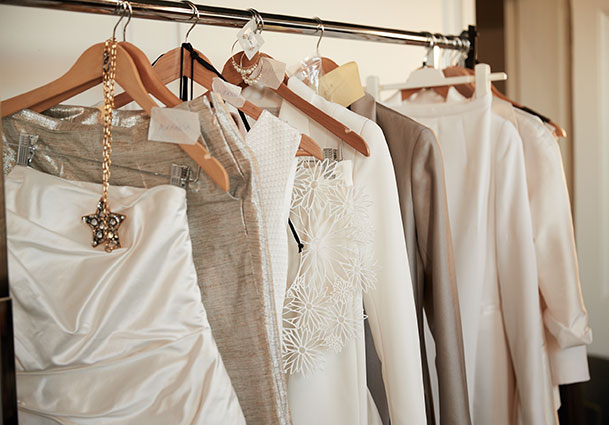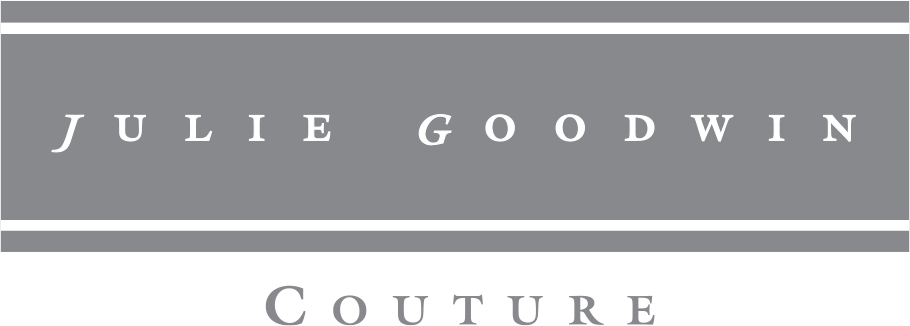Erin Modaro interviews Julie Goodwin

Erin Modaro interviewed me earlier this year and despite being a Journalism student at Macquarie University, reading this article had me questioning her age (young) and experience (not much).
Erin has perfectly translated the passion and love I have for my craft and I am blown away. She did one interview with me, over the phone, and when I read her article I felt as if she truly understood where I was coming from and had somehow managed to express it better than I could myself.
Take a minute to read it and tell me you don’t agree that this is a lady with a big future ahead of her.
Thanks Erin, it was a pleasure…
Tailor Made by Julie Goodwin
In our modern life, the time of craftsmanship is passing. Today, the economic push for consumerism and mass production shapes the way we approach what we wear. Almost gone are the days when artisans would create things processes that took time and expertise to make items of both practicality and beauty.
Individualised clothing, or couture, is a process that is almost exclusively offered to men in the making of their suits. However, in a small studio in Melbourne, Julie Goodwin makes bespoke clothing exclusively for women. Julie seems to be a lone wolf in Australia. She offers women the same options for bespoke clothing as men, outside the realm of bridal.
“I’ve never been even vaguely interested in menswear. Many of my client’s husbands ask about having things made for them but I’ve just… I’ve never done it” Julie says.
She strictly designs for women, with clients that include Melbourne’s barristers, lawyers and doctors. While couture might be the technical term for the type of fashion Julie makes, her brand is far from the aristocratic image of the big fashion labels. She represents couture’s fundamental beginnings of simply making clothes that fit. In essence, Julie is an artist for women’s bodies. An artisan, who creates beautiful garments with the utmost quality.
Julie’s work, above all else, takes time. And, rather synonymously with production time, comes the steep price tag. When I asked why Julie thought not many others did what she does within Australia, her answer was simple –
“It’s really time consuming. And to be honest, it’s really hard to charge enough for it.”
Julie has an outstanding point, one that factors largely into the narrative of craftsmanship. To make something with expertise, individuality and beauty, it takes an immense number of hours to create. On top of that are the years of work that go into becoming a professional in a particular medium. Julie’s beginning in the world of couture started from a young age, when she simply had the desire to make her own clothing. “I’ve always sewn, so I’ve always made clothes from when I was a child.” She even remembered the colour of her first sewing machine. Blue.
The way in which Julie started her business in couture is rather unconventional. Julie spotted a company that was doing something similar to what she wanted to do. It happened that the company was in the process of closing down.
“I hired all of their staff” Julie said. “It was called Her Story. They sold fabric and then made clothes. I hired their cutter, their corset and bead person, their seamstress.” She then began to learn how to create couture clothing from her staff. During this apprenticeship, Julie developed her own individual style.
“It really did develop into my own way of doing things, which just worked out really well because it’s what sets my stuff apart.”
Her business really is incredibly unique. Scrolling through the gallery on her website, Julie showcases many different styles of clothing, yet they are all united by a sleek and sophisticated look.
“It’s all about the silhouette.”
Julie is speaking about her jackets, the ones that showcase her signature sculptural form. Images in her website’s gallery show how the jacket is expertly curved, fitting snuggly to the model’s waist and accentuating the feminine lines. Julie considers her jackets to be somewhat of a signature item in her work. She mentions that the shape is internally structured – she does a lot of structured work to the interior of the garment – but the exterior is beautifully curved. The attention payed to the inside of the garment adds integrity. This workmanship is often noticed by the untrained eye like an aura; you can’t put your finger on exactly what makes it look so beautiful.
Something precious is lost in the production lines of fast fashion. It’s lost in the huge agricultural mission to produce materials, spinning millions of miles of fabric into millions of identical items which are then feathered out to the public. The quality versus quantity debate has been around long enough to identify that something is missing, like this aura of mysterious beauty that makes couture special.
A capitalist model of constant growth and an exponentially growing market has left little space for artisans. It’s now easier and cheaper than ever for people to have large and well stocked wardrobes. The saturation of our stores and boutiques with thousands of different designs and styles at affordable prices allows people of any class to own enormous amounts of clothes. Often these clothes are trickled down copies of high fashion labels from previous seasons, especially in Australia, which is reasonably distant from the fashion capitals of the world.
What the public seems to value is an unlimited choice of affordable clothing. This mindset can be applied to many aspects of life where artisans could represent the opposite: homewares, art, furniture, glassware – anything you can pick up at the shops for a quick buck. Today’s consumers want lots, they want it cheap, and they want it now.
Julie spoke about sustainability in her brand as if it were a trendy buzz word. Thrown around here and there when it came to her business model, but something that wasn’t at the core of her motivation for making clothes. It’s trendy to be sustainable in fashion, especially as the environmental impact of the fashion industry is becoming more widely understood. Yet, exactly how sustainability can be applied when it comes to our clothes is illusive.
Often, ethical clothing is about where materials are sourced. Designer labels will tout organic cotton, recycled plastic materials, and ethically sourced wool. What is perhaps missing is a solution of simply owning fewer clothes. And yet a dilemma emerges – which large brand in the fashion industry would be incented to sell fewer products? The space to value what we already have, and to seek long-lasting and well-made clothes, doesn’t fit in our current climate of mass production and mass consumption that leads to mass waste. Even if Julie isn’t motivated singularly by sustainable ethos, she does feel as if bespoke clothing has a relevant place in our lives.
“I think that this is my time in fashion.” Julie seemed to be sure that the growing movement of sustainable fashion could augment her own style of fashion.
“There’s a lot of talk about sustainability, and wearability.”
This word – wearability – is what seems to better fit Julie’s work. To be able to simply wear clothing, unhindered by ephemeral trends, incorrect fits and bad quality materials feels like an outdated concept. Perhaps our ability to truly value our possessions is sustainability at its core. To own fewer clothes, that you will own for ten, even twenty years could be an answer.
Julie described her coats as being like heirlooms.
“I make a jacket or a coat and it will be in your wardrobe for at least ten years, if not for the rest of your life. A lot of my overcoats are heirlooms. You pass them down from generation to generation.”
It’s a beautiful thought. To own a treasured item that can carry on a legacy for several lifetimes is something to be coveted, wanted. Having this apply to our clothing may seem unattainable, but it can be achieved if people come to value owning less and appreciating more.
This ideal does seem to be somewhat out of reach for most. Julie even admits to being a culprit of having her own large collection of clothes. “You should my wardrobe – it’s enormous!” she remarked, laughing at herself. Shifting one’s values is never an easy thing, especially if they have been shaped by the years of mass availability of affordable clothing. But Julie’s clientele revels a level of appreciation for bespoke clothing that certainly has room to grow. I asked what type of people she has coming into the studio, expecting a different answer.
“Most of my clients are really down to earth… it’s important that we get along.”
This reveals another defining aspect of couture: it’s incredibly personal nature. Julie mentions that she makes a lot of friends in her line of work. “Probably three of my five closest friends, the friendships have started by making clothes for them.” To have someone create an item that is specifically made for you is a special experience. Perhaps something that not many people get to encounter.
Certainly, Julie’s work is keeping something special alive. Although in decline, the work of artisan’s across Australia still is treasured and admired. To be a creator like Julie is to bring items into being from hours of careful work and attention- and it’s noticeable. The well-dressed women of Melbourne who invest in Julie’s couture are doing their bit to keep craftsmanship alive.
This article first appeared on Linkedin

